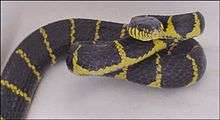Boiga
| Boiga | |
|---|---|
 | |
| Boiga dendrophila, mangrove snake | |
| Scientific classification | |
| Kingdom: | Animalia |
| Phylum: | Chordata |
| Subphylum: | Vertebrata |
| Class: | Reptilia |
| Order: | Squamata |
| Suborder: | Serpentes |
| Family: | Colubridae |
| Subfamily: | Colubrinae |
| Genus: | Boiga Fitzinger, 1826 |
Boiga is a large genus of mildly venomous, opisthoglyphous or rear-fanged, colubrid snakes typically known as the cat-eyed snakes or just cat snakes. They are primarily found throughout southeast Asia, India and Australia, but due to their extremely hardy nature and adaptability have spread to many other suitable habitats around the world. There are 34 recognized species in the genus.[1]
Species

- Boiga andamanensis (Wall, 1909) - Andaman cat snake
- Boiga angulata (W. Peters, 1861) - Leyte cat snake
- Boiga barnesii (Günther, 1869) - Barnes' cat snake
- Boiga beddomei (Wall, 1909) - Beddome's cat snake
- Boiga bengkuluensis Orlov, Kudryavtzev, Ryabov & Shumakov, 2003
- Boiga blandingii (Hallowell, 1844) - Blanding's tree snake
- Boiga bourreti Tillack, Ziegler & Le Khac Quyet, 2004
- Boiga ceylonensis (Günther, 1858) - Sri Lanka cat snake
- Boiga cyanea (A.M.C. Duméril, Bibron & A.H.A. Duméril, 1854) - green cat snake
- Boiga cynodon (F. Boie, 1827) - dog-toothed cat snake
- Boiga dendrophila (F. Boie, 1827) - mangrove snake or gold-ringed cat snake
- Boiga dendrophila annectens (Boulenger, 1896)
- Boiga dendrophila dendrophila (F. Boie, 1827)
- Boiga dendrophila divergens Taylor, 1922
- Boiga dendrophila gemmicincta (A.M.C. Duméril, Bibron & A.H.A. Duméril, 1854)
- Boiga dendrophila latifasciata (Boulenger, 1896)
- Boiga dendrophila levitoni Gaulke, Demegillo & Vogel, 2005
- Boiga dendrophila melanota (Boulenger, 1896)
- Boiga dendrophila multicincta (Boulenger, 1896)
- Boiga dendrophila occidentalis Brongersma, 1934
- Boiga dightoni (Boulenger, 1894) - Pirmad cat snake
- Boiga drapiezii (H. Boie in F. Boie, 1827) - white-spotted cat snake
- Boiga forsteni (A.M.C. Duméril, Bibron & A.H.A. Duméril, 1854) - Forsten's cat snake
- Boiga gokool (Gray, 1835) - arrowback tree snake
- Boiga guangxiensis Wen, 1998
- Boiga irregularis (Merrem, 1802) - brown tree snake
- Boiga jaspidea (A.M.C. Duméril, Bibron & A.H.A. Duméril, 1854) - jasper cat snake
- Boiga kraepelini (Stejneger, 1902) - Kelung cat snake
- Boiga multifasciata (Blyth, 1861) - many-banded cat snake
- Boiga multomaculata (F. Boie, 1827) - many-spotted cat snake
- Boiga nigriceps (Günther, 1863) - black-headed cat snake
- Boiga nuchalis (Günther, 1875) - Ashahar's cat snake
- Boiga ochracea (Günther, 1868) - tawny cat snake
- Boiga philippina (W. Peters, 1867) - Philippine cat snake
- Boiga pulverulenta (Fischer, 1856) - Fischer's cat snake
- Boiga quincunciata (Wall, 1908)
- Boiga ranawanei Samarawickrama, Samarawickrama, Wijesena, & Orlov, 2006 (2005) - Ranawana's golden cat snake
- Boiga saengsomi Nutphand, 1985 - banded cat snake
- Boiga schultzei Taylor, 1923 - Schultze's blunt-headed tree snake
- Boiga siamensis (Nootpand, 1971) - gray cat snake
- Boiga tanahjampeana Orlov & Ryabov, 2002
- Boiga trigonata (Schneider, 1802) - Indian gamma snake
- Boiga trigonata trigonata (Schneider, 1802)
- Boiga trigonata melanocephala (Annandale, 1904)
- Boiga wallachi Das, 1998 - Nicobar cat snake
Description
Cat snakes are long-bodied snakes with large heads and large eyes. They vary greatly in pattern and color. Many species have banding, but some are spotted and some are solid-colored. Colors are normally black, brown, or green with white or yellow accents.
Behaviour
They are primarily arboreal, nocturnal snakes.
Diet
They prey on various species of lizards, small snakes, and birds.
Venom
Their venom toxicity varies from species to species, but is not generally considered to be life-threatening to humans. Since their venom doesn't usually harm humans, they are popular exotic pets.
Reproduction
Boiga species are oviparous.[2]
In captivity
Boiga dendrophila is by far the most common species in captivity, but Boiga cynea and Boiga nigriceps are also found. Nowadays, B. cynodon, B. philippina and a “Katherine morph” B. irregularis are also circulating in the South-East Asian exotic pet trade. Others are not commonly available. They are hardy and adaptable and tend to do well in captivity after the initial period of stress from the importation process is passed. They are not bred commonly in captivity, so most specimens available are wild caught, and thus are prone to heavy internal parasite load. Adjusting them to a rodent only diet can be difficult for the inexperienced reptile keeper.
Invasive species
Boiga irregularis in particular has been federally banned in the United States because of its effect by accidentally being introduced to the island of Guam. Some time during the 1950s, these snakes (or possibly a single female with eggs) reached the island, possibly having hidden in imported plant pots. The island of Guam lacks native snakes or predators that can deal with snakes the size and aggressiveness of Boiga irregularis. As a result, they have bred unchecked as an invasive species, and began consuming the island's bird life in extreme numbers. Currently, dozens of bird species have been completely eradicated from the island, many species that were found nowhere else on earth, and the snake has reached astonishing population densities, reported to be as high as 15,000 snakes per square mile. In addition to devouring the native fauna, this species will routinely crawl into power transformers, and, unfortunately for all involved, this typically results in both an electrocuted snake and substantial blackouts.[3]
References
- ↑ Wikispecies. species.wikimedia.org/wiki/Boiga.
- ↑ http://www.stoppinginvasives.org/dotAsset/aa46f8a3-9334-4e55-b724-5f63ffaffc7f.pdf
- ↑ "The Brown Treesnake on Guam". Fort Collins Science Center, United States Geological Survey.
Further reading
- Fitzinger, L.I. 1826. Neue Classification der Reptilien nach ihren natürlichen Verwandtschaften. Nebst einer Verwandtschafts-tafel und einem Verzeichnisse der Reptilien-Sammlung des k.k. zoologischen Museums zu Wien. J.G. Heubner. Vienna. five unnumbered pages + 67 pp. + one plate. (Genus Boiga, p. 60.)
External links
- Genus Boiga at The Reptile Database
- Wild Herps.com: Eastern Brown Tree Snake
- Gernot-Vogel.de: Checklist of the Genus Boiga (Serpentes: Colubridae)